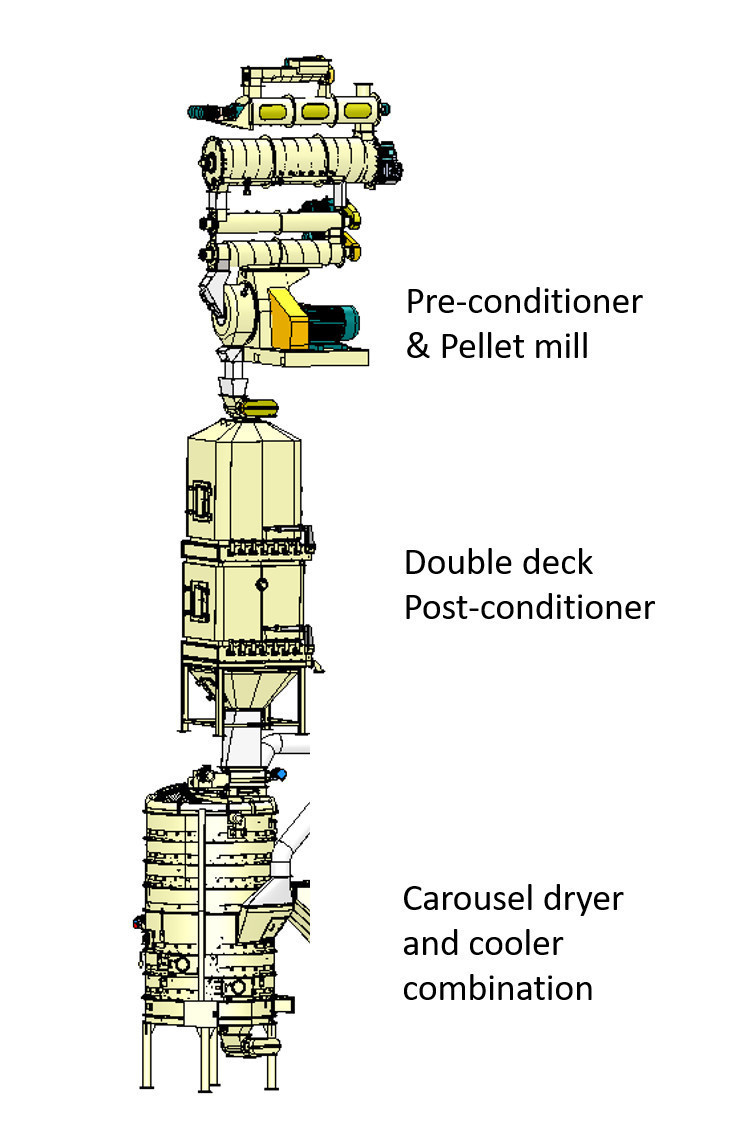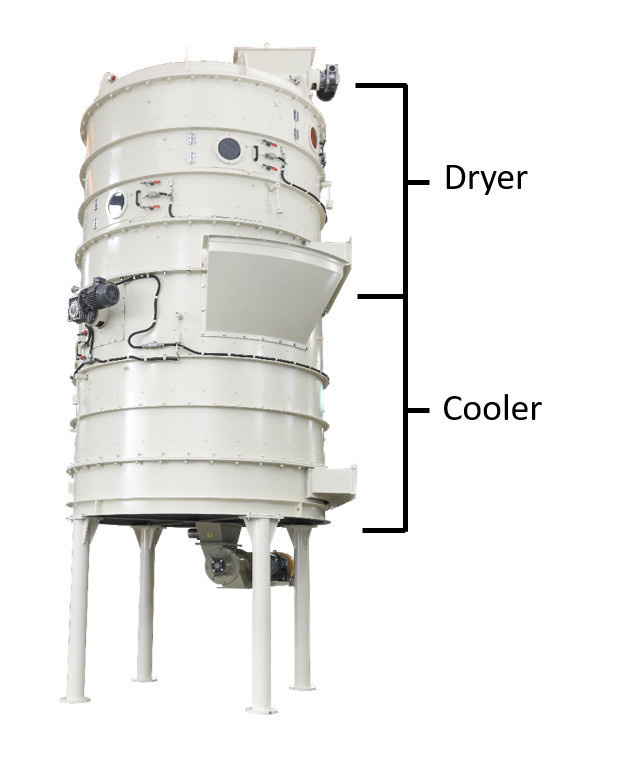Drying and Cooling shrimp feed in One machine
This article is published in Aquafeed Magazine Vol 14 Issue 3 July 2022
Understanding drying and cooling processes for pelleted shrimp feed
Development of shrimp feed
A few decades ago, a Japanese scientist Dr. Motosaku Fujinaga (also known as Dr. Hudinaga), became a pioneer in the technology of shrimp spawning and larval rearing. This technology development is an important milestone that marks the start of in-land shrimp cultivation. In the 1970s, commercial shrimp feed was sold to the public. These pellets are fast sinking and water-stable (Chamberlain, 2010).
Pelleted feed production in the early days
Early day formulation of shrimp feed incorporated a high percentage of an aquatic animal protein source, such as fishmeals or squid meal, which was readily digestible for the shrimp digestive tract (higher FCR) (Yun et al., 2017). The early pelleting process only incorporated a small amount of moisture and no significant drying process was needed.
The limitation and rising price of the animal-based feed source promoted the usage of a reasonable amount of plant-based protein, such as soybean meal as a protein source substitute (Hasan, 2001; Suárez et al., 2009). The incorporation of plant-based meals induced the need for a better ingredient cooking process because the cooking process can denature these plant proteins and promote starch cooking.
The first generation of shrimp feed pelleting system
The first-generation (G1) of shrimp feed production machine, popular from the 1980s until the 2010s, consisted of a pellet mill, a post-conditioner, and a cooler. This machine setup can prolong the mash cooking while taking out a small amount of moisture. The pre-conditioner system with direct steam spraying incorporated into the pelleting system in the 1980s helped increase the moisture content of the mash by around 2-3% (wb). The higher moisture improvement can increase the feed stability in water. The following post-conditioning and cooling process will remove approximately 1-2% moisture from the feed, resulting in the finished product with a moisture content of 10-11%, a shelf-stable pelleted feed moisture content during storage.

Figure 1. The third-generation (G3) shrimp feed pelleting system development offers total moisture control and saves drying energy.

Figure 2. The ±0.5% moisture variance in the carousel dryer-cooler lowers the amount of production flow control point in the shrimp feed pelleting production line.
Incorporation of the carousel dryer to shrimp feed pelleting lines
Even though the G1 technology is still a popular option in many Asian countries, there is a growing demand to increase the incorporation of sustainable plant-based protein while keeping water stability (Bae et al., 2020). One way to improve the water stability of a plant-based protein is by adding moisture to the mash. The benefits of increasing the moisture content during mash cooking are the increase of starch cooking and the lubricating effect of the mash when passing the pelleting hole.
Carousel dryer was first incorporated into the shrimp pelleting line back in 2013 in a large Indian shrimp feed manufacturing company. This started the second generation (G2) pelleting system. This dryer can fulfill all conditions needed to dry the shrimp feed properly and produce high-quality shrimp feed. Nowadays, the G2 system has become popular and utilized in many different pelleting lines in Asia.
The incorporation of the carousel dryer after the postconditioning process in the production line opens up the possibility of increasing the mash moisture before the pelleting process, due to the ability of the dryer to take out 4-5% of moisture content from the feed. The significant improvement of G2, when compared with the G1 in shrimp feed drying, are:
- Optimum drying moisture control. The carousel dryer can dry material with ±0.5% moisture variance, much less than the G1 (± 1%). Having adequate moisture control means the water content in pellets can be precisely controlled and indirectly reduce the loss of raw materials.
- The dryer optimally utilizes the drying air, thus minimizing energy use.
- The G2 technology can reduce steam usage for the post-conditioning system by up to 15%.
Latest drying and cooling technology for shrimp feed pellet
So what is the latest technology in drying and cooling shrimp feed? We considered all the requirements and the experience in the field and have developed a Generation 3 (G3) pelleting system that incorporates the dryer and cooler (TK-series) in one machine (Fig. 1). IDAH sold the TK-series machine to China and India back in 2021 (Fig. 2). The two benefits of this G3 system, when compared to G2 system, are:
- Total moisture control: easy and fast. The TK-series can produce feed with ±0.5% moisture variance in both dryer and cooler. This combination solved the high moisture variance problem that usually occurs when applying the conventional box cooler. This TK-series machine lessens the point to control in the production flow.
- Saving drying energy. In a carousel dryer, the counterflow drying airflow will support efficient heat transfer and give a low exhaust air temperature. The system utilizes the air exhaust from the cooler as makeup air for the dryer. The dust-free makeup air discharged from the cyclone (or jet filter) still contains some amount of heat and can lower the energy use (15- 30%) and reduce the amount of air emission (30-50%) and decrease odor problems.
Conclusion
In the past 40 years, there have been breakthroughs in shrimp feed production technology. Along with the changes in the formulation from animal-based to become plant-based, we also utilized new technologies to enable the production of high-quality shrimp feed. The main changes were, first, the moisture level increase during the pre-pelleting process, which improved the cooking process and water stability; second, the post-conditioning system prolonged the cooking of the pellets; and lastly, the incorporation of carousel dryers, which gave total moisture control (+/- 0.5%), energy-saving (15-30%), and lower dust/odor exhaust (30-50%) that benefited feed producers.

